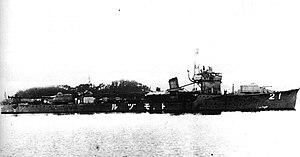Japanese torpedo boat Tomozuru
 Tomozuru in 1934
| |
| History | |
|---|---|
| Name | Tomozuru |
| Builder | Maizuru Naval Arsenal |
| Launched | 1 October 1933 |
| Completed | 24 February 1934 |
| Fate | Sunk 24 March 1945 |
| General characteristics as built | |
| Class and type | Chidori-class torpedo boat |
| Displacement |
|
| Length | 82 m (269 ft 0 in) |
| Beam | 7.4 m (24 ft 3 in) |
| Draught | 2.5 m (8 ft 2 in) |
| Speed | 30 knots (35 mph; 56 km/h) |
| Complement | 113 |
| Armament |
|
| General characteristics after rebuilding | |
| Displacement |
|
| Draft | 2.38 m (7 ft 10 in) |
| Speed | 28.0 knots (32.2 mph; 51.9 km/h) |
| Range | 1,600 nmi (3,000 km) at 14 kn (16 mph; 26 km/h) |
| Armament |
|
Tomozuru (友鶴) was one of four
The Tomozuru Incident
In February 1934, Tomozuru joined the 21st Torpedo Flotilla at
- 01:00, 12 March 1934, Tomozuru departed from (千鳥).
- 03:25, because of stormy weather, Tatsuta ordered the other two boats to return to base.
- 03:58, radio contact lost with Tomozuru. Possible loss of power or radio capability.
- 04:12, Tomozuru's lights disappeared, presumably this is when it capsized.
- 14:05, a rescue plane discovered the capsized Tomozuru drifting.
- 07:00, 13 March 1934, Tomozuru was towed by Tatsuta back to Sasebo. 100 crew were lost.
The instability of the Chidoris arose from Japanese efforts to circumvent the various naval treaties. They had designed small vessels of around 600 tons, but with the weaponry of a destroyer of twice the displacement. Weight had been saved by lighter construction but gun systems remained complex and heavy. After the launch of the lead ship, its high centre of gravity - even higher than feared - had been noted and efforts made to remedy this. High-speed sea trials showed it to be unstable, however, and further efforts were made to rectify the problem by adding bulges to the hull. Eventually Chidori satisfied the examiners and it was commissioned and the construction of the class, including Tomozuru, proceeded. At the time of its loss, Tomozuru was low on consumables such as fuel or water that would have ballasted it and lowered its centre of gravity. On the other hand, munitions were fully loaded, so the situation was significantly worse than on its sea trials.
Consequences
The cause of Tomozuru capsizing was a low metacentric height. The IJN established a committee and inspected the stability of all vessels. As a result of the inspection, the IJN discovered a lack of rolling performance, among others, in the following vessels:
- Aircraft carriers : Ryūjō
- Cruisers : Mogami class
- Destroyers : Fubuki, Akatsuki and Hatsuharu classes
- Submarine tenders : Taigei
- Minelayers : Natsushima and Tsubame classes
- Minesweepers : No.13 classes
- Subchasers : No.1 class
The significance of this incident is that it severely challenged Japanese assumptions over the stability of their warships and prompted a major review of the design of all Japanese warships. Existing vessels had their superstructures reduced and ships planned and under construction were redesigned during 1934-35. In particular the Mogami-class cruisers were significantly altered.
Service

The ship was later repaired and saw service against China and in
During the war the rear gun was landed and replaced with
Tomozuru was sunk 220 km north-west of
Notes
- ^ Whitley, p. 209
References
- Brown, David K. (2009). Antony Preston (ed.). "Weather and Warship Casualties 1934-1944". Warship. London: Conway. pp. 143–53. ISSN 0142-6222.
- Whitley, M. J. (1988). Destroyers of World War 2. Cassell Publishing. ISBN 1-85409-521-8.
